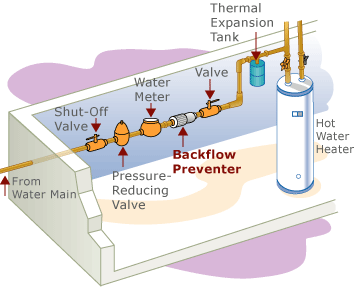What is Backflow?

What is Backflow?
Backflow occurs when the water in a pipe is forced to flow in reverse. This can occur in two ways; backpressure and back-siphonage. Backflow can cause a health threat because of a cross connection (e.g. chemicals, pesticides, bacteria, and industrial waste) that can flow into your drinking water as a result.
What is Backflow Prevention?
Backflow prevention refers to the stoppage of an unwanted reverse flow of water from a potentially polluted source into the drinking water supply. Backflow prevention valves are installed in all water systems to prevent the chance of contaminated water finding its way back into the water system. Under Government legislation, these valves require annual testing by certified tradespeople. Domestic, commercial and industrial customers need to be aware of their responsibilities to prevent backflow. Properly designed and installed plumbing systems will ensure protection. You can improve protection by installing and maintaining backflow prevention devices. This is where Backflow Central can help!
When does Backflow occur?
Backflow occurs because a condition exists in a water supply system that will cause back-siphonage or back-pressure. Back-siphonage can occur on a property through a vacuum created in the water supply system. An example of back-siphonage would be a pipeline breakage, undersized pipe work or high withdrawal rates. Back-pressure can occur within properties when high pressure is generated downstream by pumps, thermal expansion or elevation.
Safeguarding against a backflow occurrence? A correctly selected backflow prevention device (one way valve) will eliminate any risk of contamination of the drinking water supply. Backflow devices are either testable or non-testable types with the selection dependant on the risk associated with the possible contamination.
Application and Registration of a Backflow Prevention device?
Testable backflow devices require annual testing and are registered by the local authority responsible for the water supply.
Backflow Maintenance?
Water based epidemics are without doubt life threatening and historically many cases of water contamination have been traced to defective valves in consumer, business and industrial environments. Backflow prevention devices protect the population by preventing the threat from pollutants entering the supply and contaminating our drinking water. Without them there is the potential for contaminants such as fertilizers, chemicals and even poisons to enter the supply chain. Regular inspection and annual testing of backflow prevention devices to confirm that no contaminants are entering our precious water supply are required by the plumbing code. The local council maintains a register of all backflow devices. Testable backflow devices require annual testing and are registered by the local authority responsible for the water supply.
